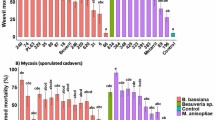Abstract
The aim of this study was to select virulent strains of microfungi against Leucoagaricus gongylophorus, a symbiotic fungus cultivated by leaf-cutting ants. The results from in vitro assays showed that microfungal strains had a variable and significant impact on the colony development of L. gongylophorus. Specifically, Trichoderma harzianum, Escovopsis weberi CBS 810.71 and E. weberi A088 were more effective, inhibiting the L. gongylophorus colonies by 75, 68 and 67%, respectively (P < 0.05) after 15 days. Strain E. weberi A086 and Acremonium kiliense were less effective: 43 and 26%, respectively (P < 0.05). In spite of the current negative perspective of a microbiological control approach for these ants, the present work discusses the possibility of using mycopathogenic fungi for the control of these insects, and points out the importance of encouraging more studies in this area.
Similar content being viewed by others
References
TR Schultz RA Meier (1995) ArticleTitleA phylogenetic analysis of the fungus-growing ants (Hymenoptera: Formicidae: Attini) based on morphological characters on the larvae Syst. Entomol. 20 337–370
R Singer (1986) The Agaricales in Modern Taxonomy Koeltz Scientific Books Koenigstein-Germany
UG Mueller (2002) ArticleTitleAnt versus fungus versus mutualism: ant-cultivar conflict and the deconstruction of the Attine ant-fungus symbiosis Am. Nat. 160 67–98 Occurrence Handle10.1086/342084
AC Silva-Pinhati M Bacci SuffixJr. ML Hinkle ML Sogin FC Pagnocca VG Martins OC Bueno MJA Hebling (2004) ArticleTitleLow variation in ribossomal DNA and internal transcribed spacers of the symbiotic fungi of leaf-cutting ants (Attini: Formicidae) Braz. J. Med. Biol. Res. 37 1463–1472 Occurrence Handle15448866 Occurrence Handle1:CAS:528:DC%2BD2cXps1ykurw%3D Occurrence Handle10.1590/S0100-879X2004001000004
G Stahel (1943) ArticleTitleThe fungus gardens of the leaf-cutting ants J. New York Bot. Garden 44 245–253
RJ Quinlan JM Cherrett (1979) ArticleTitleThe role of fungus in the diet of the leaf-cutting ant Atta cephalotes (L.) Ecol. Entomol. 4 151–160
A Silva M Bacci SuffixJr CG Siqueira OC Bueno FC Pagnocca MJA Hebling (2003) ArticleTitleSurvival of Atta sexdens on different food sources J. Insect Physiol. 49 307–313 Occurrence Handle12769984 Occurrence Handle1:CAS:528:DC%2BD3sXjtFWht7o%3D Occurrence Handle10.1016/S0022-1910(03)00004-0
NA Weber (1979) Fungus culturing by ants LR Batra (Eds) Insect-fungus Symbiosis, Mutualism and Commensalism New York John Wiley 77–116
SC Carreiro FC Pagnocca OC Bueno M Bacci SuffixJr MJA Hebling AO Silva (1997) ArticleTitleYeasts associated with nests of the leaf-cutting ant Atta sexdens rubropilosa Forel, 1908 Antonie van Leeuwenhoek 71 243–248 Occurrence Handle9111918 Occurrence Handle1:STN:280:DyaK2s3ms1Witw%3D%3D Occurrence Handle10.1023/A:1000182108648
CR Currie UG Mueller D Malloch (1999) ArticleTitleThe agricultural pathology of ant fungus gardens Proc. Natl. Acad. Sci. 96 7998–8002 Occurrence Handle10393936 Occurrence Handle1:CAS:528:DyaK1MXltVOku70%3D Occurrence Handle10.1073/pnas.96.14.7998
PJ Fisher DJ Stradling BC Sutton LE Petrini (1996) ArticleTitleMicrofungi in the fungus gardens of the leaf-cutting ant Atta cephalotes: a preliminary study Mycol. Res. 100 541–546 Occurrence Handle10.1016/S0953-7562(96)80006-2
CR Currie AE Stuart (2001) ArticleTitleWeeding and grooming of pathogens in agriculture by ants Proc. R. Soc. Lond. B 268 1033–1039 Occurrence Handle1:STN:280:DC%2BD3M3pt1OrsA%3D%3D Occurrence Handle10.1098/rspb.2001.1605
AEF Little T Murakami UG Mueller CR Currie (2006) ArticleTitleDefending against parasites: fungus-growing ants combine specialized behaviours and microbial symbionts to protect their fungus gardens Biol. Lett. 2 IssueID1 12–16 Occurrence Handle10.1098/rsbl.2005.0371 Occurrence Handle17148313
R Powell DJ Stradling (1986) ArticleTitleFactors influencing the growth of Attamyces bromatificus, a symbiont of attine ants Trans. Br. Mycol. Soc. 87 205–213 Occurrence Handle1:CAS:528:DyaL2sXislSr Occurrence Handle10.1016/S0007-1536(86)80022-5
CR Currie (2001) ArticleTitlePrevalence and impact of a virulent parasite on a tripartite mutualism Oecologia 128 99–106 Occurrence Handle10.1007/s004420100630
HT Reynolds CR Currie (2004) ArticleTitlePathogenicity of Escovopsis weberi: The parasite of the attine ant-microbe symbiosis directly consumes the ant-cultivated fungus Mycologia 96 955–959
A Rodrigues FC Pagnocca OC Bueno LH Pfenning M Bacci SuffixJr. (2005) ArticleTitleAssessment of microfungi in fungus gardens free of the ants Sociobiology 46 317–322
JJ Muchovej TMC Della Lucia (1990) ArticleTitle Escovopsis, a new genus from leaf-cutting ant nests to replace Phialocladus nomen invalidum Mycotaxon 37 IssueID1 191–195
A Rodrigues FC Pagnocca M Bacci SuffixJr MJA Hebling OC Bueno LH Pfenning (2005) ArticleTitleVariability of non-mutualistic filamentous fungi associated with Atta sexdens rubropilosa nests Folia Microbiol. 50 421–425 Occurrence Handle1:CAS:528:DC%2BD28XosFWnsA%3D%3D Occurrence Handle10.1007/BF02931424
JH Zar (1996) Biostatistical Analysis EditionNumber3 Prentice-Hall New Jersey
A Ortiz S Orduz (2000) ArticleTitle In vitro evaluation of Trichoderma and Gliocladium antagonism against the symbiotic fungus of the leaf-cutting ant Atta cephalotes Mycopathologia 150 53–60 Occurrence Handle10.1023/A:1010843413085
E Diehl-Fleigh ME Silva A Specht ME Valim-Labres (1993) ArticleTitleEfficiency of Beauveria bassiana for Acromyrmex spp Control (Hymenoptera: Formicidae) Ann. Soc. Entomol. Brasil 22 281–285
A Kermarrec G Febvay M Decharme (1986) Protection of leaf-cutting ants from biohazards: is there a future for microbiological control? CS Lofgren RKV Meer (Eds) Fire Ants and Leaf-Cutting Ants: Biology and Management Westview Press London 339–356
E Lopez S Orduz (2003) ArticleTitle Metarhizium anisopliae and Trichoderma viride for control of nests of the fungus-growing ant, Atta cephalotes Biol. Control 27 194–200 Occurrence Handle10.1016/S1049-9644(03)00005-7
PJ Neves SB Alves (1999) ArticleTitleControle associado de Cornitermes cumulans (Kollar, 1832) (Isoptera: Termitidae) com Metarhizium anisopliae, Beauveria bassiana e Imidacloprid Sci. Agric. 56 IssueID2 305–311
PMOJ Neves SB Alves (2000) ArticleTitleGrooming capacity inhibition in Cornitermes cumulans (Kollar) (Isoptera: Termitidae) inoculated with entomopathogenic fungi and treated with imidacloprid An. Soc. Entomol. Brasil 29 537–545
Author information
Authors and Affiliations
Corresponding author
Rights and permissions
About this article
Cite this article
Silva, A., Rodrigues, A., Bacci, M. et al. Susceptibility of the ant-cultivated fungus Leucoagaricus gongylophorus (Agaricales: Basidiomycota) towards microfungi. Mycopathologia 162, 115–119 (2006). https://doi.org/10.1007/s11046-006-0037-6
Received:
Accepted:
Issue Date:
DOI: https://doi.org/10.1007/s11046-006-0037-6




